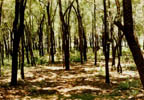|
| Search |
- Home
-
Tourism
- Tourism
- Visiting Swaziland
- Visiting SNTC Areas
- The Lubombo Route
- Interactive Maps
-
Cultural Resources
- Cultural Resources
- Museum
- National Monuments
- Archaeology
- King Sobhuza II Memorial Park
- Mantenga Cultural Village
- Swazi Culture
- Swazi History
- Nature Reserves
-
Biodiversity
- Biodiversity
- Swaziland's Flora
- Swaziland's Fauna
- Research Projects
-
Programmes
- Programmes
- Park Management
- Education
- Community Outreach
- Research
- BCPD
- Wetlands
- TFCAs
- Legislation
| Mlawula Nature Reserve - Vegetation | ||||
Vegetation Types(a) Bushclump Grassland and Open Grassland This category includes the open grassland areas and grassland with termitaria based bushclumps found on the top of the Lubombo mountains. (b) Moist Broadleaved Savanna This vegetation type occurs on moister soils and is dominated by broadleaved, often deciduous species. (c) Acacia nigrescens Savanna/Woodland Acacia nigrescens has been used to characterise this vegetation type, although there is great variation in woody species composition within this category. For example, in the shallower soils of the southern parts of the Siphiso valley, the Acacia nigrescens woodland includes a high proportion of Grewia hexamita. (d) Pioneer Acacia Woodland This vegetation type occurs on areas that had previously been cultivated or cleared. They are characterised by the dominance of Acacia and Dichrostachys species. (e) Mixed Combretaceous Woodland On the western ridges, the dominant species is Combretum apiculatum; on the Lubombo escarpment, Combretum apiculatum is the dominant species on the lower slopes, and higher up, Combretum molle becomes the dominant species. The boundary between this category and the Acacia nigrescens Savanna/Woodland is not always clearly defined. Rocky areas on the Lubombo escarpment comprise a sub-type of this woodland where tree and shrub density is reduced by both rock sheets and loose rocks. (f) Forest/Thicket This category includes riverine forests, Androstachys johnsonii forests, dry Spirostachys africana thickets and open thicket mosaics (riverine, sodic and saline areas). (i) Thickets and thicket mosaics These vary from open thicket mosaics to closed thickets. Included in this category are those found on saline and sodic soils as well as Spirostachys africana thickets. (ii) Lowveld Dry Forest and Thicket This includes riverine forest. Along the Mbuluzi river, this type used to be extensive until large areas were destroyed by flooding at the time of cyclone Domoina. (iii) Lubombo forest and thicket Most of the forest in the ravines of the Lubombo mountains within the reserve is dry forest, but it does include some small pockets of moist forest. The dry forests include Androstachys johnsonii forests. A greater diversity of species is found along the watercourses running through the Androstachys forests as well as through the other dry forests. Download large version of Vegetation Map (jpg, 535 KB) 
|
QUICK LINKS Site Map Contact Links Reference Material Discussions Updates RELATED PAGES Mlawula Flora Mlawula Flora Checklist |


